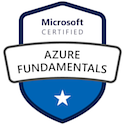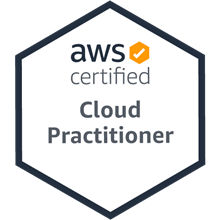
Why not Both: Learning AWS and Azure Fundamentals Hands-On
Post • 6 min read
The two biggest cloud vendors have of course their own certifications: AWS Certified Cloud Practitioner and AZ-900 (Microsoft Certified: Azure Fundamental). These certifications allow you to have a deep dive on the basics of AWS or Azure. Both providers recommend that you have basic IT knowledge and at least 6 months of experience working with the provider in question before starting the process.
I'll admit it, the task may sound daunting. Who has one minute to spare, let alone 6-12 months, watching videos that you have to pay attention to really closely, or reading a ton of boring white papers, 300+ pages long each? But what if I told you about another way: learning by doing.
Then comes the wallet hit; Oops, I didn't know how much AWS resources started to add up.
Lucky for me, it was only $5, but that is money that I didn't want to spend. I navigated over to the Simple Monthly Calculator provided by AWS and started to build my solutions here before implementing them in my Free-tier account. Sometimes it would say I needed to pay a lot, but it was a monthly calculator and not based on my usage for 1-2 days. Now that I understand the billing, account management, and pricing models it was time for me to learn how I can create a support ticket. Sorry AWS, but I had to learn.
I wanted to see if I could get a soft-limit of 5 VPC to increase to 6. So, I wrote a nice mail to AWS Support:
Hi AWS Support Team,
Can you increase the VPC limit to 6. Just testing out how to increase AWS limits.
Thanks :D
Shocking to me it was done the next business day. That was with the basic support plan. Kudos to AWS.
Microsoft launched a new learning platform called Learn. If you have ever used the Microsoft Virtual Academy, it is an updated version of that. First thing I started with was Introduction to Azure and Azure Fundamentals. Both courses took me just about 1-2 hours to complete.
What I really liked about Microsoft Learn was the ability to have Hands-on-learning. It allowed me to put my reading skills to practical use. I finished up my AZ-900 training with Architecting Great Solutions on Azure and Manage Resources in Azure. Both of the courses took me about 1-3 days to finish and I also went back to do more of the modules.
Here you can see the similarities and differences between the two certifications.
I would state that doing the AWS training first definitely helped me pass the Azure training.
Wish you the best of luck on passing AWS Certified Cloud Practitioner and AZ-900 (Microsoft Certified: Azure Fundamental)!
I didn't want to just pass the exam. I wanted to learn new technologies surrounding the cloud and expand my understanding of what the cloud actually was.In this post, I'll give you an overview of both of these certifications and explain how I skipped reading hundreds of pages of manuals and learned by building my own solutions hands-on. Below in detail I have included the curriculum to study to pass the exam. However, I didn't want to just pass the exam. I wanted to learn new technologies that would expand my understanding of what the cloud actually is.
I have previously written about my Cloud Practitioner journey, but in that post I didn't exactly touch on how I prepared for the examination. So here we go. I fired up my desktop computer and created an AWS account first. I went over to Qwiklabs and started to create real-life scenarios like "Introduction to Amazon Virtual Private Cloud", "Creating an Amazon Virtual Private Cloud with AWS CloudFormation", and "Introduction to AWS Identity and Access Management (IAM)". How do I create a basic website or create a blog like the one you are reading from now. From here I started to understand the AWS Cloud architectural principles and basics.
Azure Fundamentals

With the AWS Certified Cloud Practitioner exam passed, it was time for me to understand more about Azure. When I got to the Azure exam in January 2019, they already released AZ-900 (Microsoft Certified: Azure Fundamental). As you might have already figured out, I do not like reading white papers, but rather work things out on my own. Once again, I tracked down my stationary desktop and got down to business.
AWS vs Azure: Certification Comparison
| AWS | Azure | |
|---|---|---|
| Exam Objectives |
|
|
| Main Subject Areas |
|
|
| Preparation Notes |
|
|
| Exam Process |
|
|
| Pass/Fail |
|
|
Get in Touch.
Let’s discuss how we can help with your cloud journey. Our experts are standing by to talk about your migration, modernisation, development and skills challenges.

Ilja’s passion and tech knowledge help customers transform how they manage infrastructure and develop apps in cloud.
Ilja Summala
LinkedIn
Group CTO
